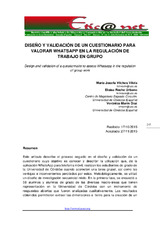Mostrar el registro sencillo del ítem
Diseño y validación de un cuestionario para valorar Whatsapp en la regulación de trabajo en grupo
| dc.contributor.author | Vilches Vilela, M. Josefa | |
| dc.contributor.author | Reche Urbano, Eloísa | |
| dc.contributor.author | Marín-Díaz, Verónica | |
| dc.date.accessioned | 2018-10-16T10:51:31Z | |
| dc.date.available | 2018-10-16T10:51:31Z | |
| dc.date.issued | 2015 | |
| dc.identifier.uri | http://hdl.handle.net/10396/17290 | |
| dc.description.abstract | Este artículo describe el proceso seguido en el diseño y validación de un cuestionario cuyo objetivo es conocer y describir la utilización que, de la aplicación WhatsApp para telefonía móvil, realizan los estudiantes de grado de la Universidad de Córdoba cuando acometen una tarea grupal, así como las ventajas e inconvenientes percibidos por estos. Metodológicamente, se utilizó un diseño de investigación secuencial mixto. En la primera fase, se encuestó a 58 alumnos y alumnas de grado de las diversas macro-áreas que tienen representación en la Universidad de Córdoba con un instrumento de respuestas abiertas que fueron analizadas cualitativamente. Los resultados obtenidos permitieron extraer las dimensiones e ítems para la creación de un cuestionario inicial. En la segunda fase, el instrumento diseñado fue aplicado a un grupo informante compuesto por 78 estudiantes con las características anteriormente citadas que fue sometido a diferentes pruebas de validación psicométrica con el objeto de averiguar su fiabilidad y validez para su posterior generalización | es_ES |
| dc.description.abstract | This article describes the process followed in the design and validation of a questionnaire whose goal is to understand and describe the use of the application WhatsApp for mobile telephony, carried out by the students of degree from the University of Cordoba as they wrestle a task group, as well as the advantages and disadvantages accruing to these. Methodologically, we used a research design sequential mixed. In the first phase, surveyed 58 students of degree of the various macro-areas that have representation at the University of Cordoba with an instrument of open-ended responses that were analysed qualitatively. The obtained results allowed to remove the dimensions and items for the creation of an initial questionnaire. In the second phase, the instrument designed was applied to a group informant composed of 78 students with the above-mentioned characteristics was subjected to various validation testing Psychometric to find out its reliability and validity for its further generalization | es_ES |
| dc.format.mimetype | application/pdf | es_ES |
| dc.language.iso | spa | es_ES |
| dc.publisher | Universidad de Granada | es_ES |
| dc.rights | https://creativecommons.org/licenses/by-nc-nd/4.0/ | es_ES |
| dc.source | Eticanet XV (15) II, 245-272 (2015) | es_ES |
| dc.subject | es_ES | |
| dc.subject | Software social | es_ES |
| dc.subject | Trabajo en grupo | es_ES |
| dc.subject | Enseñanza superior | es_ES |
| dc.subject | Estudios mixtos | es_ES |
| dc.subject | Validación de escalas | es_ES |
| dc.subject | Scale validation | es_ES |
| dc.title | Diseño y validación de un cuestionario para valorar Whatsapp en la regulación de trabajo en grupo | es_ES |
| dc.title.alternative | Design and validation of a questionnaire to assess Whatsapp in the regulation of group work | es_ES |
| dc.type | info:eu-repo/semantics/article | es_ES |
| dc.relation.publisherversion | http://www.eticanet.org | es_ES |
| dc.rights.accessRights | info:eu-repo/semantics/openAccess | es_ES |

